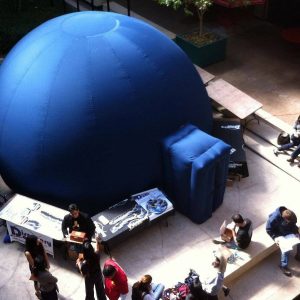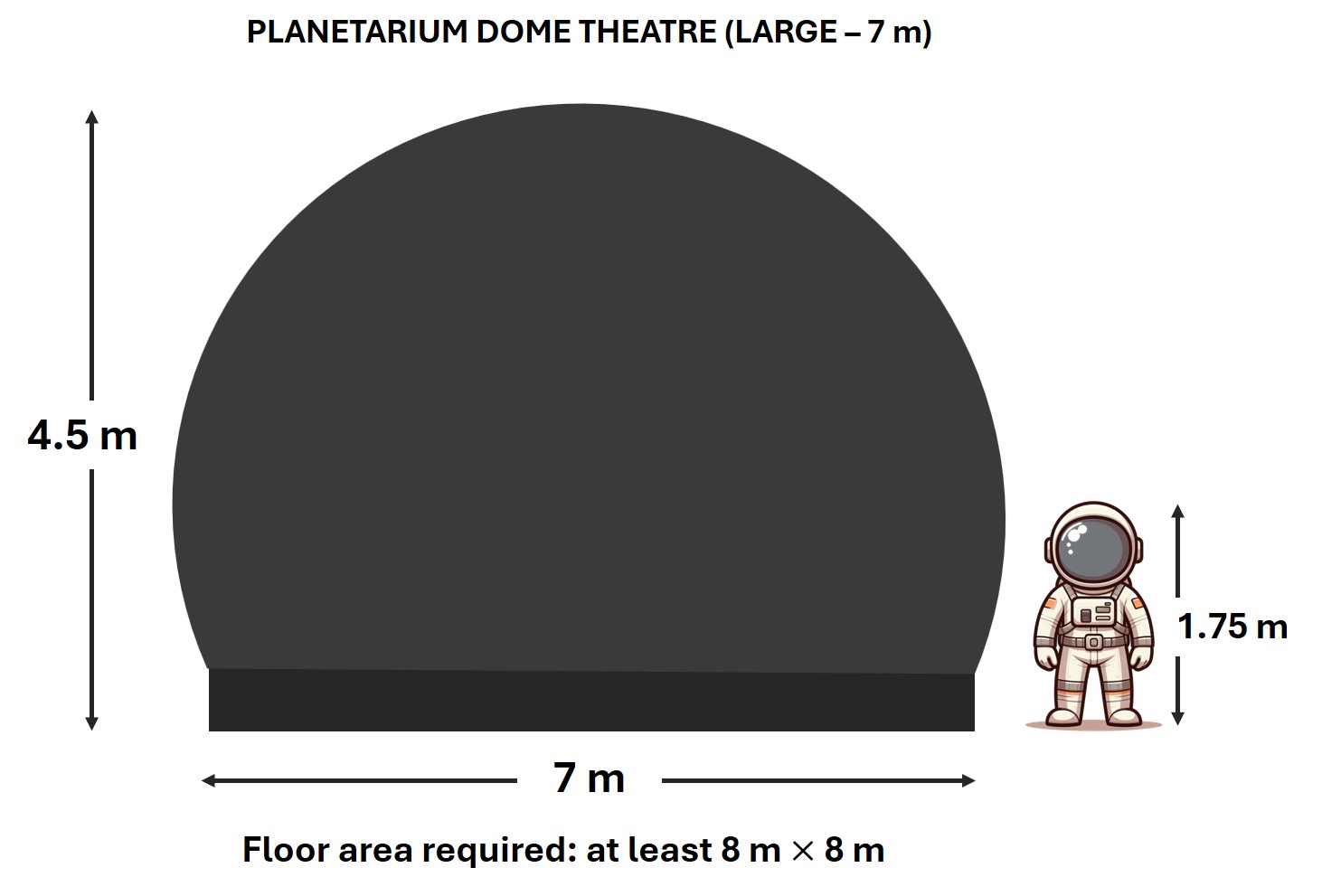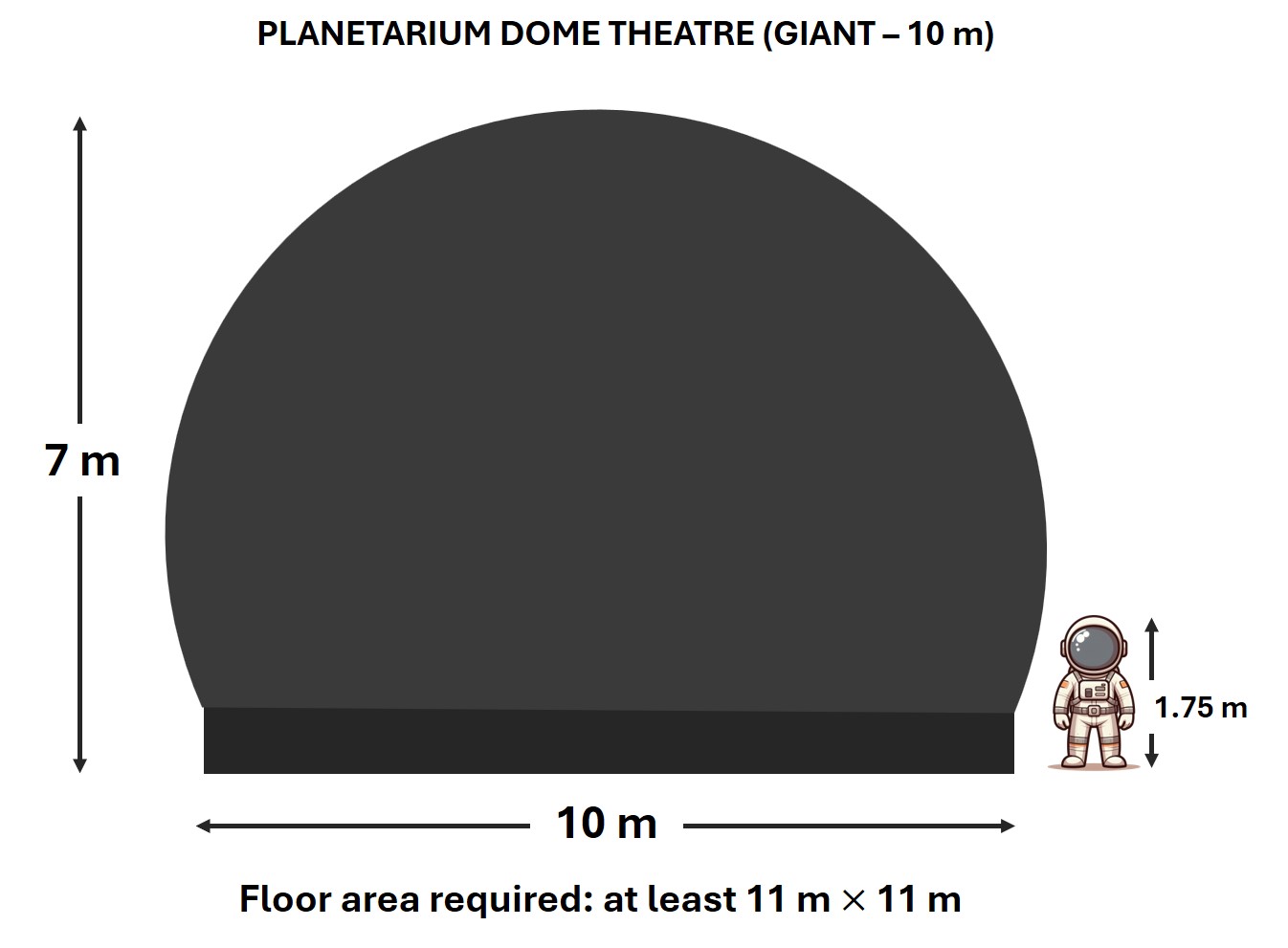HomeBusiness & EventsMobile Planetarium Domes
Mobile Planetariums

OVER 22 DOMES IN OUR PORTFOLIO
We have the world’s largest stock of domes, from 3m – 27m.
Utilising both geodesic and inflatable domes for indoor and outdoor use as well as open air domes to create quickly deployable venues for events.


MOBILE PLANETARIUM
Introducing our ‘Gold Standard’ fleet of domes from Immersive Experiences®
- Integrate our various projection solutions, up to 4k from one single projector, either fisheye or Newtonian
- DLP, Laser, 3D projectors available
- VR, AR, 3D integration
- Accessible for a wide audience range, including wheelchairs, special needs, induction loops
- Available in either Blue or Black outside cloth colour
- The ‘5-second dome flip’ provides a fast emergency exit in case of emergency evacuation
- Fully flame-retardant fabric with certification
- Positive pressure domes, means even with a power outage, the dome remains up longer, allowing the audience to exit safely
- Internal ventilation air system to allow better air flow, reducing mould, mildew, bacteria and virus formations
- UV sterilisable screens with no colour damage
- The airlock design simulates space age technology — beginning their “out of this world” experience. The double-door, vestibule design creates a quick seal behind each admittance so that light, late arrivals or those who must leave unexpectedly do not disturb your show in progress. The dome door is 7 feet tall in 5m or more domes, allowing easy “walk-in” entry with minimum air loss per admittance.
- Our airlock door is easily detached from the floor to allow wheelchair users easier access
- The entryway has a continuous non-skid floor that allows the vertical tubes to move sideways to allow adults to enter.
- Our custom-made soft grey projection screen reduces cross-reflection (internal reflections that cause dark areas to be illuminated by reflections from bright areas) for rich colours and pleasurable viewing.
- The optimised surface is shine-free which allows even the brightest digital dome shows to be viewed without glare. The special fabric also reduces sound reflections, making the experience the best it can be.
- The cloth used in each product is custom made and designed with the highest standards possible for fire retardancy. Each batch of cloth manufactured has to pass stringent laboratory testing for fire retardancy before it is accepted for manufacturing of the dome. The doorway can be zippered shut for full-dome projection applications but can be left open for easy access.
- The dome features self-regulated outlet vents in the side opposite the door, which open up for through-circulation with the dome is fully inflated, and automatically close if the dome loses air when a group exits.
- The air inlet from the fan is forked: part to inflate the door-way and part goes directly into the dome near the doorway to provide efficient air circulation inside the dome, keeping the projection system cool.
- The vent system not only keeps air circulating inside the dome but stops the characteristic “Bouncing” of typical closed system domes – if the dome overinflates, the vents open completely with a light baffle. No bouncing means no strobing light leaks to disturb the presentation inside!

RAISED MOBILE PLANETARIUM
Introducing our ‘authentic feel’ fleet of domes from Immersive Experiences®
For customers needing a more traditional planetarium theatre experience, we offer domes with rings.These rings give the dome a vertical wall below the projection surface (also known as spring line).The rings are inflated by the same fan that inflates the dome. Each ring has a diameter of 30 cm (1 foot) and up to 5 rings can be provided for the spring line desired by the customer. The primary purpose of the rings is to raise the projected horizon in the dome. By using three or more rings, standard folding chairs can be used in the dome for seating and the fulldome image is projected above the heads of the seated audience.
- One or two Rings hold the dome diameter and adds to stability. Three to five Rings provide a wall against which chairs can be placed.
These domes are heavier than the standard dome, but many our customers find applications where a dome is set up for more than one day or even as a temporary planetarium theatre in museums or other public spaces such as shopping centres, schools, universities, events etc. Ring domes have been made in sizes ranging from 4-meter domes fitting in exhibitions, arts, and music venues with tall ceilings to 8-meter portable theatres. The rings are permanently attached to the dome and are not detachable in any way.
- The airlock design simulates space age technology — beginning their “out of this world” experience. The double-door, vestibule design creates a quick seal behind each admittance so that light, late arrivals or those who must leave unexpectedly do not disturb your show in progress. The dome door is 7 feet tall in 5m or more domes, allowing easy “walk-in” entry with minimum air loss per admittance.
- Our airlock door is easily detached from the floor to allow wheelchair users easier access
- The entryway has a continuous non-skid floor that allows the vertical tubes to move sideways to allow adults to enter.
- Our custom-made soft grey projection screen reduces cross-reflection (internal reflections that cause dark areas to be illuminated by reflections from bright areas) for rich colours and pleasurable viewing.
- The optimised surface is shine-free which allows even the brightest digital dome shows to be viewed without glare. The special fabric also reduces sound reflections, making the experience the best it can be.
- The cloth used in each product is custom made and designed with the highest standards possible for fire retardancy. Each batch of cloth manufactured has to pass stringent laboratory testing for fire retardancy before it is accepted for manufacturing of the dome. The doorway can be zippered shut for full-dome projection applications but can be left open for easy access.
- The dome features self-regulated outlet vents in the side opposite the door, which open up for through-circulation with the dome is fully inflated, and automatically close if the dome loses air when a group exits.
- The air inlet from the fan is forked: part to inflate the door-way and part goes directly into the dome near the doorway to provide efficient air circulation inside the dome, keeping the projection system cool.
- The vent system not only keeps air circulating inside the dome but stops the characteristic “Bouncing” of typical closed system domes – if the dome overinflates, the vents open completely with a light baffle. No bouncing means no strobing light leaks to disturb the presentation inside!
SAFETY FEATURES
- The ‘5-second dome flip’ provides a fast emergency exit in case of emergency evacuation
- Fully flame-retardant fabric with certification
- Positive pressure domes, means even with a power outage, the dome remains up longer, allowing you to exit the audience
- Internal ventilation air system to allow better air flow, reducing mould, mildew, bacteria and virus formations
- UV-sterilisable screens with no colour damage
Dome specs
4/5 M DOME
6 M DOME
4/5 M DOME
Diameter | 4/5 m (13.1/16.4 ft)
Height | 3.1 m (10.2 ft)
Capacity | 5 – 35
CAPACITY
30-35 Ages 3–4
25-30 Ages 5–8
20-25 Ages 8–11
15-20 Ages 11–13
10-15 Ages 13–15
5-10 Adults
6-8 Small wheelchairs
SETUP
30-45 minutes setup
20-30 minutes de-rig
1 x standard UK power socket (13amp)
1 x 16amp outdoor supply
1 x 16amp optional supply for A/C
SPACE REQUIREMENTS
Indoors:
6m x 6m x 3m high
Outdoor Marquee:
9m x 9m x 4m high
Clean solid floor area, concrete, wood, brick or dry level grass
6 M DOME
Diameter | 6m (19.7 ft)
Height | 4m (13.1 ft)
Capacity | 15 – 45
CAPACITY
40-45 Ages 3–4
35-40 Ages 5–8
30-35 Ages 8–11
25-30 Ages 11–13
20-25 Ages 13–15
15-20 Adults
8-10 small wheelchairs
SETUP
45-60 minutes setup
20-30 minutes de-rig
1 x standard UK power socket (13 amp)
1 x 16 amp outdoor supply
1 x 16 amp optional supply for air conditioning
SPACE REQUIREMENTS
Indoors:
7m x 7m x 4m high
Outdoor Marquee:
9m x 9m x 5m high
Clean solid floor area, concrete, wood, brick or dry level grass
7 M DOME
8 M DOME
7 M DOME
Diameter | 7m (23 ft)
Height | 4.5m (14.8 ft)
Capacity | 30 – 60
CAPACITY
55-60 Ages 3–450-55 Ages 5–8
45-50 Ages 8–11
40-45 Ages 11–13
35-40 Ages 13–15
30-35 Adults
10-12 small wheelchairs
SETUP
45-60 minutes setup20-30 minutes derig
1 x standard UK power socket (13 amp)
1 x 16 amp outdoor supply
1 x 16 amp optional supply for air conditioning
SPACE REQUIREMENTS
Indoors:
8m x 8m x 4.5m high
Outdoor Marquee:
12m x 12m x 5m high
Clean solid floor area, concrete, wood, brick or dry level grass
8 M DOME
Diameter | 8m (26.2 ft)
Height | 5m (16.4 ft)
Capacity | 45 – 75
CAPACITY
70-75 Ages 3–465-70 Ages 5–8
60-65 Ages 8–11
55-60 Ages 11–13
50-55 Ages 13–15
45-50 Adults
12-15 small wheelchairs
SETUP
45-60 minutes set up20-30 minutes derig
1 x standard UK power socket (13 amp)
1 x 16 amp outdoor supply
1 x 16 amp optional supply for air conditioning
SPACE REQUIREMENTS
Indoors:
9m x 9m x 5m high
Outdoor Marquee:
12m x 12m x 5m high
Clean solid floor area, concrete, wood, brick or dry level grass
9 M DOME
10 M DOME
9 M DOME
Diameter | 9m (29.5 ft)
Height | 6m (19.7 ft)
Capacity | 55 – 90
CAPACITY
70-75 Ages 3–465-70 Ages 5–8
60-65 Ages 8–11
55-60 Ages 11–13
50-55 Ages 13–15
45-50 Adults
12-15 small wheelchairs
SETUP
45-60 minutes set up20-30 minutes derig
1 x standard UK power s
1 x 16 amp outdoor supply
1 x 16 amp optional supply for air conditioning
SPACE REQUIREMENTS
Indoors:
9m x 9m x 5m high
Outdoor Marquee:
12m x 12m x 5m high
Clean solid floor area, concrete, wood, brick or dry level grass
10 M DOME
Diameter | 10m (32.8 ft)
Height | 7m (23 ft)
Capacity | 80 – 120
CAPACITY
110-120 Ages 3–4100-110 Ages 5–8
90-100 Ages 8–11
90-95 Ages 11–13
85-90 Ages 13–15
80-85 Adults
20-30 small wheelchairs
SETUP
60-90 minutes set up30-45 minutes de-rig
2 x standard UK power sockets (13 amp)
2 x 16 amp outdoor supply
1 x 16 amp optional supply for air conditioning
SPACE REQUIREMENTS
Indoors:
11m x 11m x 7m high
Outdoor Marquee:
15m x 15m x 7m high
Clean solid floor area, concrete, wood, brick or dry level grass












